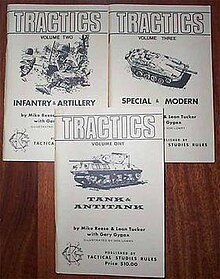
A wargame is a strategy game in which two or more players command opposing armed forces in a simulation of an armed conflict. Wargaming may be played for recreation, to train military officers in the art of strategic thinking, or to study the nature of potential conflicts. Many wargames re-create specific historic battles, and can cover either whole wars, or any campaigns, battles, or lower-level engagements within them. Many simulate land combat, but there are wargames for naval, air combat, and cyber as well as many that combine various domains.

David Lance Arneson was an American game designer best known for co-developing the first published role-playing game (RPG), Dungeons & Dragons, with Gary Gygax, in the early 1970s. Arneson's early work was fundamental to the role-playing game (RPG) genre, pioneering devices now considered to be archetypical, such as cooperative play to develop a storyline instead of individual competitive play to "win" and adventuring in dungeon, town, and wilderness settings as presented by a neutral judge who doubles as the voice and consciousness of all characters aside from the player characters.

Miniature wargaming is a form of wargaming in which military units are represented by miniature physical models on a model battlefield. Miniature wargames are played using model soldiers, vehicles, and artillery on a model battlefield, with the primary appeal being recreational rather than functional. Miniature wargames are played on custom-made battlefields, often with modular terrain, and abstract scaling is used to adapt real-world ranges to the limitations of table space. The use of physical models to represent military units is in contrast to other tabletop wargames that use abstract pieces such as counters or blocks, or computer wargames which use virtual models. The primary benefit of using models is immersion, though in certain wargames the size and shape of the models can have practical consequences on how the match plays out. Models' dimensions and positioning are crucial for measuring distances during gameplay. Issues concerning scale and accuracy compromise realism too much for most serious military applications.
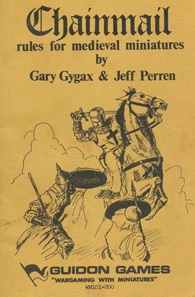
Chainmail is a medieval miniature wargame created by Gary Gygax and Jeff Perren. Gygax developed the core medieval system of the game by expanding on rules authored by his fellow Lake Geneva Tactical Studies Association (LGTSA) member Jeff Perren, a hobby-shop owner with whom he had become friendly. Guidon Games released the first edition of Chainmail in 1971.
Sniper!, subtitled "House-to-House Fighting in World War II", is a two-player board wargame about man-to-man combat in urban environments during WWII, originally released in 1973 by Simulations Publications Inc. (SPI). After TSR purchased SPI in 1982, TSR released an expanded edition of Sniper! in 1986, and followed up that up with releases of various "companion games" and a videogame.

A man-to-man wargame is a wargame in which units generally represent single individuals or weapons systems, and are rated not only on weaponry but may also be rated on such facets as morale, perception, skill-at-arms, etc. The game is designed so that a knowledge of military tactics, especially at the small unit or squad level, will facilitate successful gameplay. Man-to-man wargames offer an extreme challenge to the designer, as fewer variables or characteristics inherent in the units being simulated are directly quantifiable. Modern commercial board wargaming stayed away from man-to-man subjects for many years, though once the initial attempts were made to address the subject, it has evolved into a popular topic among wargamers.
Guidon Games produced board games and rulebooks for wargaming with miniatures, and in doing so influenced Tactical Studies Rules, the publisher of Dungeons & Dragons. The Guidon Games publishing imprint was the property of Lowrys Hobbies, a mail-order business owned by Don and Julie Lowry. About a dozen titles were released under the imprint from 1971 to 1973.

Don't Give Up the Ship is a set of rules for conducting Napoleonic era naval wargames. The game was published by Guidon Games in 1972 and republished by TSR, Inc. in 1975. The game was developed as a collaboration between Dave Arneson, Gary Gygax, and Mike Carr. It was the first collaboration between Dave Arneson and Gary Gygax, the co-authors of Dungeons & Dragons. Mike Carr edited the rules and researched the historical single ship actions that are included as game scenarios.

Siege of Bodenburg is a wargame developed in 1967 by Henry Bodenstedt. It is one of the earliest sets of rules for conducting battles with medieval miniatures.
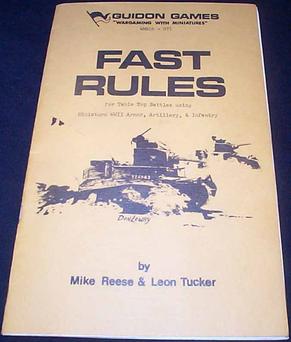
Fast Rules is a simple, playable ruleset for conducting table top wargames with H0 scale World War II miniatures using armor, artillery and infantry and classed as a "mid-level skirmish" wargame. The rules were developed by Mike Reese and Leon Tucker and published as a 24 page pamphlet in 1970 by the Armored Operations Society, an affiliate of the IFW. Guidon Games made a second printing in 1972 and a third printing at an unknown later date. Combat Rules released an full-color, authorized edition in 2021 with a few additions. Compared to the original 5.5x8.5" edition, it has 24 6.14x9.21" pages.
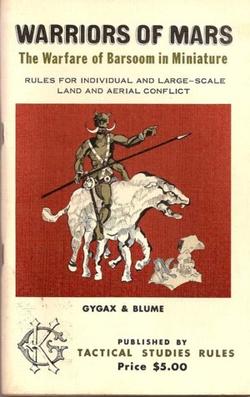
Warriors of Mars is a 1974 miniatures wargame rule book, written by Gary Gygax and Brian Blume and published by Tactical Studies Rules. It simulates combat in the fantasy world of Barsoom, originally imagined by Edgar Rice Burroughs in his series of novels about John Carter of Mars. It is a 56-page booklet in the same style as the original Dungeons & Dragons books, even sharing the same artist Greg Bell. Gygax and TSR published the rules without permission from Burroughs estate and soon after its release they issued a cease and desist order and the game was pulled from distribution. Because only a few copies were sold the book is now rare and sells for a high price.

Air wargaming, like naval wargaming, is a niche specialism within the wider miniatures wargaming hobby. Due to the relatively short time over which aerial combat has developed air wargaming periods tend to break down into three broad periods:
Donald R. Kaye was the co-founder of Tactical Studies Rules (TSR), the game publishing company best known for their Dungeons & Dragons (D&D) role-playing game. He and TSR co-founder Gary Gygax had been friends since childhood, sharing an interest in miniature war games. In 1972, Kaye created Murlynd, one of the first D&D characters, and play-tested him in Gygax's Castle Greyhawk campaign. Kaye and Gygax were convinced that D&D and similar games were an excellent business opportunity, and together they founded Tactical Studies Rules in 1973. However, only two years later, just as sales of D&D started to rise, Kaye unexpectedly died of a heart attack at age 36.

A board wargame is a wargame with a set playing surface or board, as opposed to being played on a computer or in a more free-form playing area as in miniatures games. The modern, commercial wargaming hobby developed in 1954 following the publication and commercial success of Tactics. The board wargaming hobby continues to enjoy a sizeable following, with a number of game publishers and gaming conventions dedicated to the hobby both in the English-speaking world and further afield.

The original Dungeons & Dragons boxed set by Gary Gygax and Dave Arneson was published by Tactical Studies Rules in 1974. It included the original edition of the Dungeons & Dragons fantasy role-playing game. Its product designation was TSR 2002.

Swords & Spells is a supplementary rulebook by Gary Gygax for the original edition of the Dungeons & Dragons fantasy role-playing game. Its product designation is TSR 2007.

Angriff!, subtitled "A practical set of World War II Wargaming rules for use with the HO and MICRO scale enthusiast", is a set of rules for miniature wargaming set in World War II designed especially for use with HO scale and 1:285 scale micro armor. The booklet was released by Z&M Publishing Enterprises in 1968.

Wargamer's Digest was a wargaming magazine created by Gene McCoy that was published from 1973 to 2000. It is notable as one of the earliest publications to publish the work of Gary Gygax, and for the high regard that military professionals and academics showed for its military scenarios and simulations.
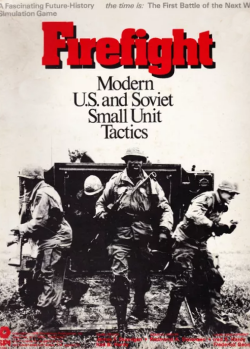
Firefight: Modern U.S. and Soviet Small Unit Tactics is a tactical wargame originally published by Simulations Publications, Inc. (SPI) in 1976 that hypothesizes combat between small units of American and Soviet forces in West Germany in the 1970s.
